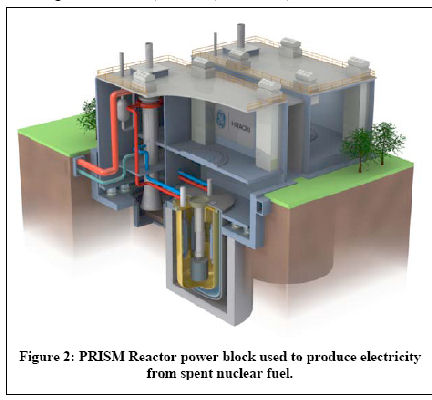
The Integral Fast Reactor (IFR, Generation 4 Reactor or Fast Neutron Reactor) was developed at Argonne National Laboratories in the United States. The project was canceled by the U.S. government in 1994 for purely political reasons, just as it was preparing its last demonstration after a decade of spectacularly successful development.
- The IFR recycles spent fuel from current nuclear reactors. Over 99% of the energy is left in the spent fuel and will provide all the energy the world needs for many centuries.
- The IFR is "walk away safe" and can't melt down.
- The IFR will convert weapons-grade material from dismantled arsenals into clean electrical energy.
- Many members of this website are the world's leading experts on IFR technology.
- The IFR, as envisioned here, is the cheapest form of renewable energy.
- Leave your preconceptions behind and give the IFR a good look, no matter what you may think about nuclear power, You will be amazed at what you find.
Virtually everything we do takes energy, even sitting around thinking. Human development requires massive amounts of energy, which in the past century or so has been derived mostly from fossil fuels: oil, gas, and coal. The combination of human development that relies on these highly polluting resources and the tremendous increases in human population has brought us to a state of nearly perpetual crisis. Several wars have been fought for control of energy resources, and more are almost inevitable unless we find alternatives. Meanwhile, air pollution circles the globe, having long ago gone beyond national borders to become a worldwide plague, with hundreds of thousands of people dying every year from air pollution. In the last couple decades, international bodies of climate scientists have concluded that anthropogenic greenhouse gas emissions are warming our planet to such an extent that detrimental and even catastrophic results can be expected if we don't get the situation under control.
There are many types of technologies that can produce energy without emitting large amounts of greenhouse gases, but unfortunately many of them are extremely diffuse and/or sporadic. An overview of the various technologies being promoted today as remedies for our energy crisis can be found in Prescription for the Planet. In the coming months many of the scientists of SCGI will contribute their writings on this website to elucidate both the promise and the limitations of each energy system. These limitations are generally inherent in the system with no conceivable way to eliminate them. For instance, on even the brightest days, in the best locations at the equator, the amount of solar energy hitting each square meter of land is limited. Collecting this energy with solar thermal or photovoltaic systems in quantities capable of making a large contribution to human energy needs is a prodigious and expensive undertaking. Wind power, even more fickle than solar, suffers from the same type of limitations. And virtually any chemical process to produce energy through combustion is limited by the often substantial but nevertheless modest potential of chemical reactions.
The glaring exception to these troublesome constraints is the incredible energy density of fission. The splitting of the atom produces enormous amounts of energy from tiny amounts of uranium fuel, as evidenced by hundreds of nuclear reactors in use around the world today. Yet a typical light water reactor utilizes only about six-tenths of one percent of the energy contained in uranium. The rest is tossed away as "nuclear waste," a troublesome commodity that will remain radioactive for hundreds of thousands of years and which has produced a political headache for governments around the world. This wastefulness has been compared to putting a log on a fire, burning off the bark, and throwing away the log.
There is, however, a solution to this problem. And this solution—the Integral Fast Reactor, or IFR—can be the solution to virtually all of the problems humanity faces today that are in any way connected to energy. Instead of recovering less than 0.6% of the energy in uranium, IFRs can utilize 100% of it, making them about 160 times more efficient than conventional reactors. They leave behind no long-lived waste products, and the small amount that is left can be easily and safely disposed of. Not only that, but IFRs can consume all the spent fuel from today's nuclear reactors, along with all the weapons-grade material from dismantled arsenals and even the enormous amounts of depleted uranium that have been accumulating around the world during the nuclear age. We have so much potential fuel already mined, in fact, that if humanity's entire energy needs were to be met solely with IFRs, we still wouldn't have to mine or enrich any uranium for nearly a thousand years.
Many of the members of SCGI are scientists who are the world's leading experts on IFR technology. In the months to come they will be contributing their knowledge and insight to explain both the technology and its tremendous potential to solve our climate and energy problems. For now, though, a good overview of IFR technology can be obtained by clicking this link, which will take you to the chapter that introduces IFR technology in Prescription for the Planet. Other links on this site will direct you to more information on IFRs, including some fascinating discussions among the advocates of various energy systems.
Integral Fast Reactors can be the game-changing technology that can lead us out of many of the crises humanity faces. It is so far beyond the current generation of nuclear power systems that to compare one with the other would be like comparing a Model T to a Lexus. Leave your preconceptions behind and give the IFR a good look, no matter what you may think about nuclear power. You will be amazed at what you find.
*** You can read the main chapter on IFR technology from Prescription for the Planet online here. ***
For an excellent brief overview, check out George Stanford's article here.
